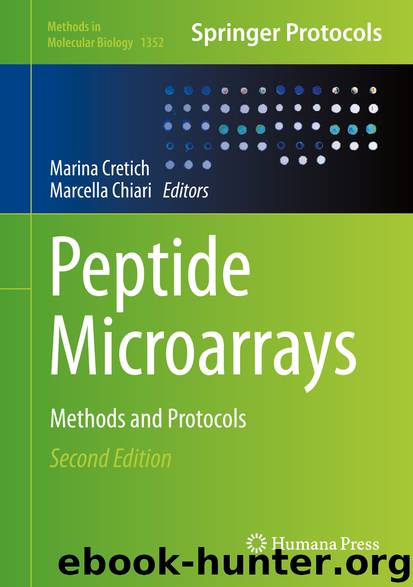Peptide Microarrays by Marina Cretich & Marcella Chiari

Author:Marina Cretich & Marcella Chiari
Language: eng
Format: epub
Publisher: Springer New York, New York, NY
Noteworthy, Lin and coworkers elegantly showed the impact of a site-specific bioconjugation strategy by selectively immobilizing the maltose-binding protein (MBP) to a glass surface through CuAAC and by evaluating its binding activity in comparison to randomly linked MBP. Results clearly evidenced that the specifically immobilized MBP preserved considerably higher binding activity than the randomly coupled MBP [15]. Further support to oriented immobilization advantages was recently reported by Zilio et al. in the functionalization of a Si-SiO2 substrate using a clickable polymeric coating to enable the attachment of azido-modified peptides. Correct orientation of peptidic probes was found significantly favorable for optimal ligand-target antibodies interaction [16]. CuAAC can also serve the purpose to produce peptide-functionalized surfaces with tunable ligand concentration or patterned topology to quantitatively ascertain complex molecular interactions [17–20]. In a seminal report, the Becker group produced a functionalized surface where the peptide ligand density was tuned by means of a gradient concentration of alkyne functional groups. Following immobilization of azido-modified RGD peptides via CuAAC, the effect of peptide concentration on cell adhesion could be quantitatively evaluated on a single slide [20]. Intriguingly, the generation of ligands gradient can arise from the local generation of the Cu(I) catalyst, as demonstrated by Larsen an collaborators [19].
The only potential limitations associated to CuAAC arise from residual copper catalyst which, depending on the system, can lead to ligand or target denaturation and/or interference with analytical signal detection. To partially overcome this issue, while also improving reaction performance, Cu(I)-binding ligands have been developed [21]. Moreover, in recent years, catalyst-free strain-promoted azide-alkyne cycloaddition (SPAAC) has also emerged as a gold-standard technique for conjugation of peptide-based probes, particularly for in vivo applications (Scheme 1b) [22]. In this case, the driving force of the reaction is uniquely given by the intramolecular strain of the cyclooctyne used as the azido counterpart; thus, no metal catalyst is required. However, the high reactivity of the cyclooctyne makes it more feasible to cross-react with other functional groups, such as cysteine thiols, leading to aspecific binding. Also, this technique is limited by the costs and the difficulties in synthesizing the cyclooctyne building blocks to be incorporated in the peptide ligand. Nevertheless, many cyclooctyne-based probes have been developed, whose reactivity and properties are modulated by electronic and steric effects [23].
For instance, the azadibenzocyclooctyne (ADIBO) shows a good compromise between reactivity and synthetic accessibility and, interestingly, was claimed to outperform conventional CuAAC in the immobilization of acetylene-functionalized glass slides with azido-functionalized peptides [24]. Pfeifer and collaborators reported on the use of ADIBO-activated slide surfaces for the preparation of high-density fluorescently labeled peptide microarrays [24]. Excellent immobilization kinetics, good spot homogeneities, and reproducible signal intensities were obtained. Also, interestingly, the specific immobilization of bovine serum albumin (BSA) and dextran via SPAAC led to reduced nonspecific binding of fluorescently labeled IgG to the microarray surface in comparison with other techniques. SPAAC-mediated microarray surface functionalization with peptides was also exploited by Chaikof and coworkers [25]. Immobilization occurred in a fast (<15 min), selective, and tunable fashion. Notably, the
Download
This site does not store any files on its server. We only index and link to content provided by other sites. Please contact the content providers to delete copyright contents if any and email us, we'll remove relevant links or contents immediately.
| Cell Biology | Developmental Biology |
| Entomology | Marine Biology |
| Microbiology | Molecular Biology |
| Biostatistics |
Sapiens: A Brief History of Humankind by Yuval Noah Harari(14210)
The Tidewater Tales by John Barth(12595)
Mastermind: How to Think Like Sherlock Holmes by Maria Konnikova(7195)
Do No Harm Stories of Life, Death and Brain Surgery by Henry Marsh(6875)
The Thirst by Nesbo Jo(6809)
Why We Sleep: Unlocking the Power of Sleep and Dreams by Matthew Walker(6597)
Life 3.0: Being Human in the Age of Artificial Intelligence by Tegmark Max(5447)
Sapiens by Yuval Noah Harari(5281)
The Longevity Diet by Valter Longo(5007)
The Body: A Guide for Occupants by Bill Bryson(4952)
The Rules Do Not Apply by Ariel Levy(4822)
The Immortal Life of Henrietta Lacks by Rebecca Skloot(4502)
Animal Frequency by Melissa Alvarez(4382)
Why We Sleep by Matthew Walker(4342)
The Hacking of the American Mind by Robert H. Lustig(4303)
Yoga Anatomy by Kaminoff Leslie(4289)
All Creatures Great and Small by James Herriot(4213)
Double Down (Diary of a Wimpy Kid Book 11) by Jeff Kinney(4178)
Barron's AP Biology by Goldberg M.S. Deborah T(4081)
